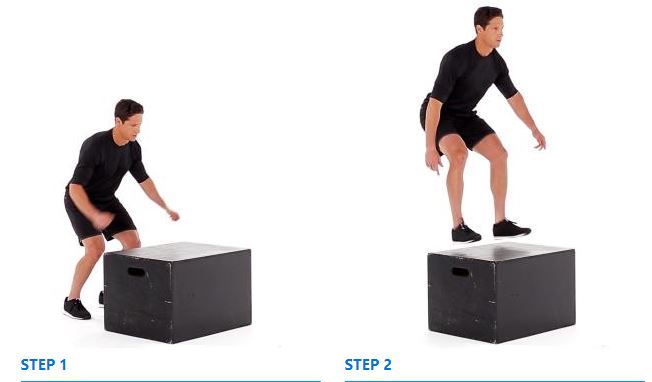Overview:
Box jumps are some of the most effective plyometric exercises you can perform and they are extremely popular in CrossFit. Apart from increasing your lower body strength and explosiveness, box jumps also increase a person’s overall speed as well as improving their coordination. The cardiovascular benefits of this exercise are also very beneficial. Including box jumps into your CrossFit WODs can help burn excess calories and body fat while toning and tightening the muscles of the lower body.
Muscles Targeted:
Box jumps help develop and strengthen the muscles in the legs, hips, glutes and core. When jumping, the muscles of the gluteus maximus, quadriceps and hamstrings are highly engaged. The core muscles of your abs, obliques and lower back work as secondary muscle groups that are also targeted as you perform this explosive movement.
Exercise Instructions:
In order to incorporate the box jump into your workout routine, the first thing you will need is a stable box to jump onto. Accuracy and balance are absolutely crucial for the proper execution of a successful box jump.
The box shown in the photos on this page is about 30 inches in height.
The choice of the box depends on each person’s athletic ability. Everyone is different, so make sure to start off with a very small box and slowly increase the size and overall height of the box being used.
Here are the following steps to use when performing this exercise:
- Stand in front of the box with your feet about shoulder-width apart. Position your body about 1-3 feet away from the box before you begin the exercise.
- Jump up and propel your body upwards with your arms being used for balance and coordination. Your arms should swing naturally as you jump. Focus on the middle part on top of the box for your landing spot.
- Keep a slight bend in your knees as you land on the box and focus on landing on the balls of your feet. This helps to cushion the body against any injury. Make sure to keep your upper body completely balanced once you land in the top position.
- Extend your legs and stand up straight on the box after the jump. This will help you regain your balance and control.
- Carefully step back onto the ground using one leg at a time. Complete the total number of repetitions in this fashion. Remember to maintain a certain distance from the box. This will help you execute the jumps safely and effectively.
Things To Avoid:
Avoid looking down at the ground while jumping. Keep your head and neck in a fixed position with your eyes focused on a certain spot on the top of the box. Avoid using an unstable box or surface to execute the jumps. Do not use a box that is too large for your level of fitness and ability. Using an unstable box or one that is too high increases the risk of injury from falling. Additionally, avoid jumping back down onto the ground as it might put too much pressure on the knees. It is recommended to step back down using one leg at a time and continue with the completion of the repetitions for your workout.
Reps and Sets:
The number of repetitions and sets used when performing the box jump totally depends on your current level of fitness. If you are just starting out, choose a very small box and shoot for only 3-4 properly executed reps. After you progress, increase the number of reps to as high as 20 per set. Using 3-4 total sets of 20 reps each should provide an incredible workout. Make sure to also take a 60-90 second rest period between sets to give you ample recovery time before you begin your next set.


